Short History and Introduction to Still-life Painting
Next studio practical course is April 5-7th 2025
The following essay is an introduction for those who might be interested enrolling on the next still-life painting course in April . The essay discusses Still-Life as an art form from prehistoric times to the very present. It starts with Cave Painting, then Egyptian Painting, Dutch Still-life, Cezanne, Cubism, Juan Gris, Morandi, Richard Diebenkorn , Jasper Johns, Michael Craig-Martin, Richard Long and Sean Scully. If you are not familiar with Still-Life as a subject then it is hoped this essay will spark off some ideas and interest.
******************
Strictly speaking Still Life, (or Nature Morte), means the depiction of inanimate objects and anything not living. By the 17th century the scope had widened and included perishables such as flora and fruit. Therefore we tend to think of still-life as a collection of the above, arranged in a certain aesthetic order, to make a well-balanced composition. However, this is only an aspect of the whole genre from its pre-history beginnings to the present day. The development has not been in a straight line, but what has been an advantage is its very long and consistent history.
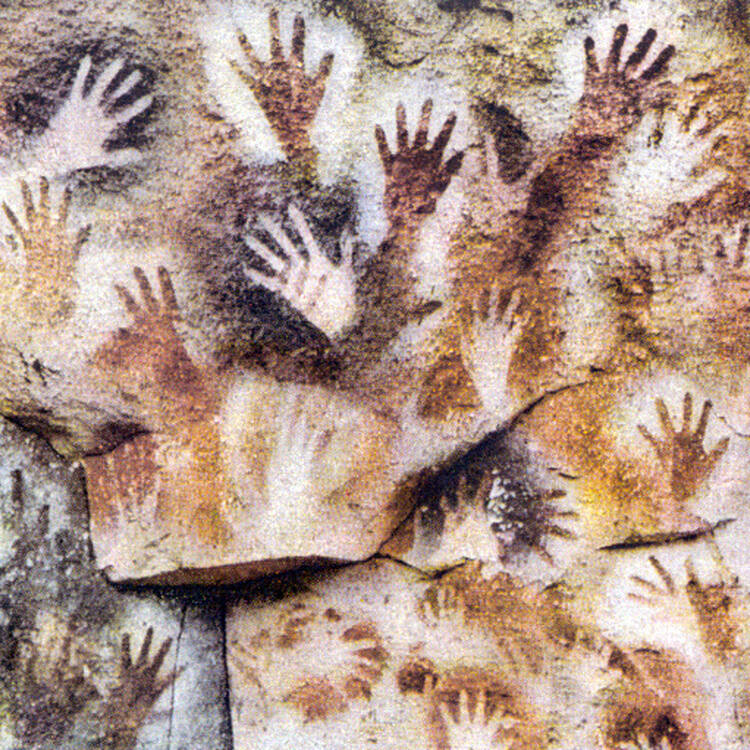
Cave Painting Patagonia circa 8,000 BC
Prehistoric Cave Paintings.
It could be said still-life painting began on cave walls around 45,000 years ago. The images were not only tales about beasts and hunting, but as much to do about human existence and creative debvelopment. Some walls were covered with an abundance of hand impressions. In one sense you might see them as still-lives. Certainly they are depictions of life, but long gone and now inanimate. What is remarkable about these impressions is they appeared for thousands of years across most continents and were very similar in application, regardless of what land mass they were made on. It then becomes evident these signs or images were part of a universal language. How this happened remains a mystery as the cave dwellers from each continent could not have possibly met or seen each-other’s art.
Hands as Stencils
When the early cave painters removed their hands from the wall, (having sprayed them with pigment), they must have been shocked with utter disbelief. What they saw were their hands, but hands where they had once been. Then to realise these hands were present and absent at the same time. In today’s language we would call this ‘a light bulb moment’.
The caves were clearly places of ritual. When the non-painters first saw the decorated cave walls they must have also experienced joy and wonderment from all the waving hands. Were they being greeted or were they saying goodbye? Were they going or coming from the underworld or life beyond? Because of the delicacy of the sprayed imagery these hands were far more sophisticated and magical, than the average handprint made with mud from the year dot.
20th Century
There are several contemporary artists who have used their own hands as part of their visual vocabulary. Jasper Johns and Richard Long are among the best known. There is no doubt they were influenced by cave art and the prehistoric era.
Please note the Jasper Johns self-portrait . The hands sit in the same kind of space as the cave painted hands on cave walls. Both seem to be behind the surface as if trapped, or in a separate world.

Jasper Johns. b.1930

Richard Long b.1945
Egyptians

Egyptian tomb painting, 1000 BC
The Egyptians decorated the inside of their tombs with food to honour their deceased and provide them with sustenance to help them on their journey into the after-life. It is not surprising the term Still- life or Nature Morte has prevailed for many centuries. Historically, and right from the beginning, many of the images used in still-life, symbolically dwelled on the theme of life and death.
Dutch
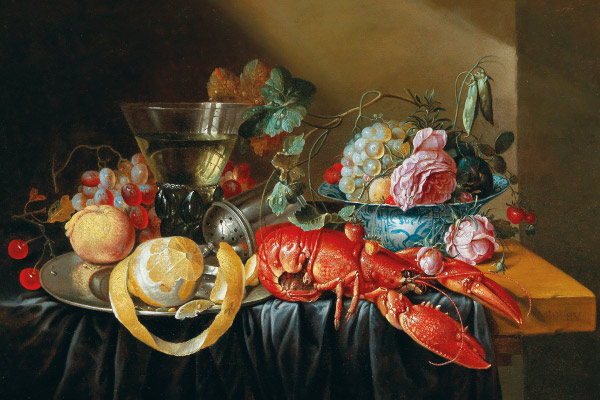
Pieter de Ring painting circa 1660 Netherlands
Still life painting, in a technical and representational way, peaked in the 17th Century with outstanding works by the Dutch Masters. Spectacular achievements in terms of composition design, light and colour. Then the combination of this type of hyper realism with the invention of photography , (much later on), were undoubtably a breaking point, which fuelled the rethinking of painting in the 19th and 20th centuries.
Cezanne
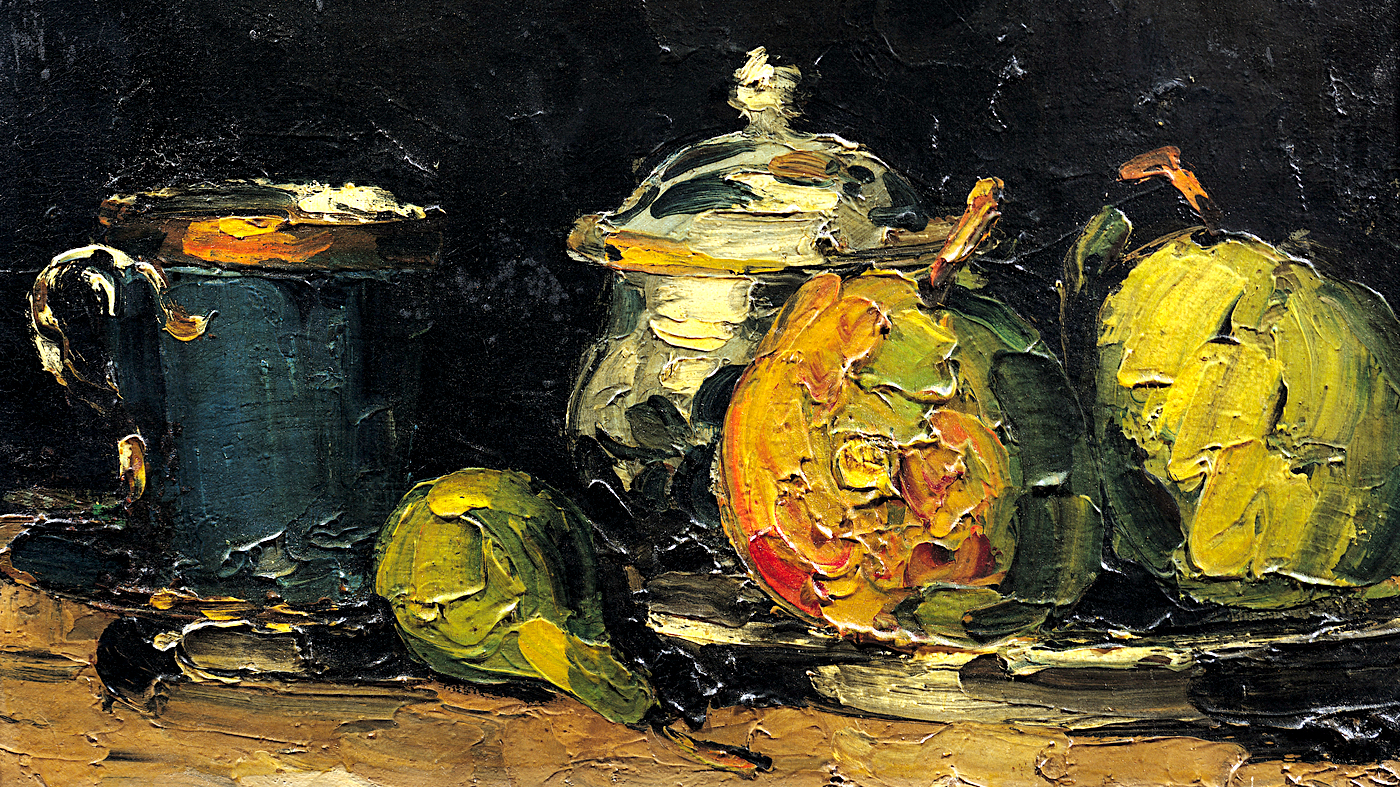
Cezanne circa 1866
The conundrum in the mid 19th century about what and how to paint was extremely central to Cezanne’s thinking. Most people would not associate this painting with him. It is from his mid-career having spent years studying and looking at the old masters. You can see echoes of Dutch and Spanish painting. You can also see how Cezanne was grappling with the whole idea of perception, representation and the interlocking of all this with the language of paint itself. The painting seems a century ahead of its time. It reminds us of the heavy impasto work by post war British painters, such as Bomberg and Frank Auerbach.
Present and past
Today in our post-modernist world still-life seems to have become a slightly old-fashioned term. However, it is still alive and kicking from its very long tradition. The Dutch masters existed some 360 years ago. The Royal Academy is presently showing a retrospective of the living artist Michael Craig-Martin (born 1941), whose take on content, constructing and designing a still life is not too dissimilar from that of the Dutch.

Michael Craig-Martin 1999
The Pieter de Ring and Craig-Martin paintings above exude opulence . The Pieter de Ring depicts beauty (Vanitas ) and luxury food in abundance, These were paintings representing a very wealthy life style and made for the rich. The Craig Martin takes mundane objects and arranges them in a similar way and then dresses them in opulent colour.
But are the Craig Martin objects and subject matter about ordinariness? On closer examination his painting is a personal history where he pays homage to his artistic heroes. The objects he has taken are from his heroes’ best-known works. Here is Duchamp’s urinal and his hat-stand, which ironically looks a bit like Pieter de Ring’s lobster, or is it an octopus? The brush-pot and light bulb is Jasper Johns. The pipe and glass of water is Magritte, but the glass could also be Craig-Martin’s famous glass of water parading as an oak tree? Who knows what the clip board represents?
Years between 1650- 2000
Before getting too distracted we need to look at some paintings between the Dutch and post-modern era. By post-modern I mean Warhol, Caulfield, Lichtenstein etc. We can forget where we have come from. There is plenty of fertile ground in these years between, which have not depended as much on graphic rendering. Artists such as Chardin, Cezanne, Juan Gris (cubism), Richard Diebenkorn and Morandi , are always worth familiarising yourselves with. These were artists in the tradition of unravelling what they saw or perceived in front of them, processed through the filter of their own eyes, more than their conceptual. The two modes coexist but it has always been a balancing act.
Morandi 1890-1964

Morandi. watercolour
Morandi started off in the Italian metaphysical movement, which was conceptual and close to surrealism. His later work never lost that intellectual rigour, as he became more concerned with perception through a direct visual approach to whatever he chose to scrutinise. Morandi was well versed in the tradition of still-life painting and became a great exponent of what we mean by ‘less is more’. He pared everything down to essentials with absolutely no frills. His greatest influence has been on the recent minimalist approach to painting whether abstract or representational.
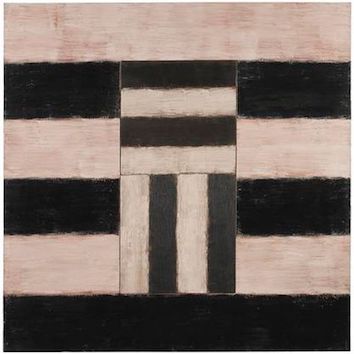
Sean Scully b 1945
Sean Scully,(illustrated above ) is an abstract artist, who was greatly influenced by Morandi. You can see the connection between the painting above and the Morandi below.
Sean Scully’s paintings are minimal and reduced to abstract elements, but what is left is something very felt and tangible.Scully has flattened pictorial depth much more than Morandi. With Morandi you definitely see objects set against backgrounds, but with Scully it is not so certain and is a much more ambiguous space.
At first glance the smaller bands, in the centre, seem to stack up to being an object with the broader horizontal bands acting as background. Then, with a more considered look, the stacked central object, with its broad banded background, seem to dissolve into one single and even surface. This flatness is quite a different experience from seeing an impenetrable wall. The painting suggests there might be an opening to a further space behind. Also worth noting is the even light that gently moves the eye across the painted surface.This also happens in a Morandi

Morandi
Both Morandi and Scully’s paintings attract a huge amount of attention as people seem to be drawn to the uncluttered painterly experience. Like Morandi , Scully binds and budges his shapes together until they settle. Both painters produce works of art which are never static or rigid. Everything is allowed to be in flux, as that seems to be the state they were made in. Paintings such as these take you to calm and contemplative places were time almost stands still. They are not too dissimilar to the territory of Mark Rothko.
Richard Diebenkorn 1922-1993

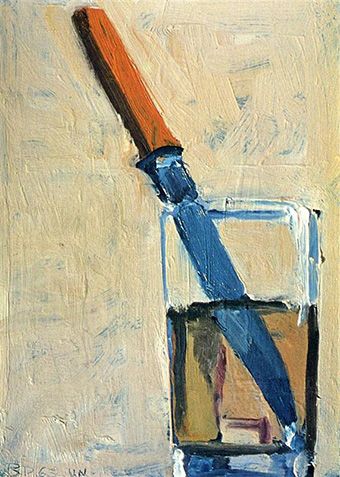
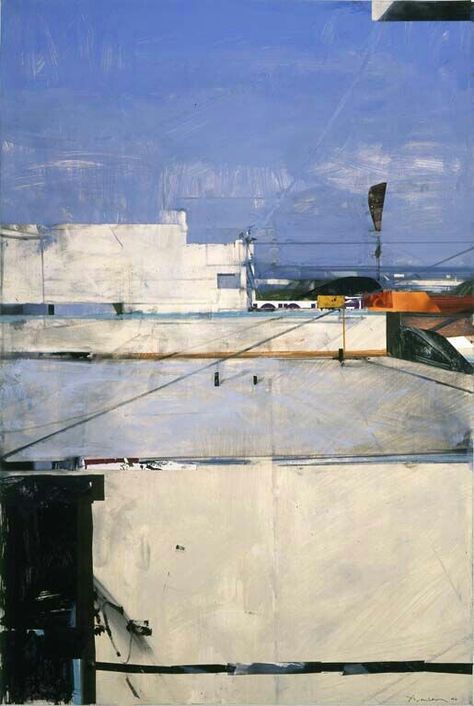
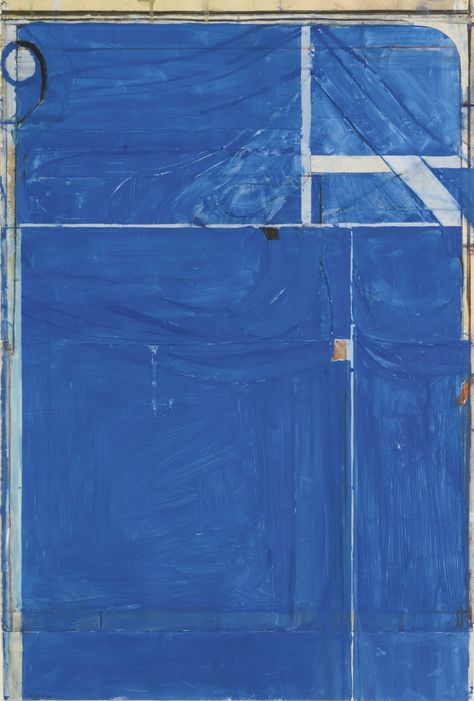
Richard Diebenkorn. An American painter who worked both figuratively and with abstraction. One fed into the other. The bottom left painting may look totally abstract but the image is derived from his studio window overlooking Ocean Park ,as is the image on the left
The lefthand top drawing is what I call a tablescape. Random objects scattered across a table, left as found and not set up or composed.
Cubism

Juan Gris 1913
Juan Gris 1887 – 1927
This painting feels very contemporary suggesting Caulfield and Craig- Martin. There are several languages of representation going on here. The table comes across as real, though the perspective has been reversed. The carpet behind falls between abstraction and figuration. The sheets of music and the artist’s palette have a reality, but not in the same way as the table which is 3 dimensional. The guitar is an image that has morphed itself into the palette, table surface and sheets of music. In the end the mind tells us a guitar is present, but the eye finds it elusive or somewhat transient; is this not unlike music itself, which appears to be the subject of this painting anyway ?
Putting Surrealism to one side, it could be argued that the greatest and most influential group artists during the 20th century were the cubists – namely Braque, Picasso and Gris. whose main subject was still-life. There was also Matisse and then later Europeans and Americans such as Richard Diebenkorn, Paul Nash, Ivon Hitchens, Mary Fedden, Prunella Cough, Giorgio Morandi, William Scott, William, Ben and Winfred Nicholson, and many others who have made huge contributions to the genre. They certainly defined and broadened our understanding of still life and much more. However, for most, still life was not an end in itself; the idiom or medium was only a vehicle they used to find and further their own ways.
Niel Bally 3/10/2024
( ref. Weekend Still-life painting courses. April 2025 . Art Course Wales.)
